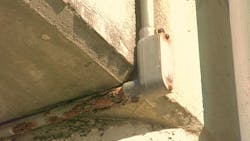How well do you know the Code? Think you can spot violations the original installer either ignored or couldn't identify? Here's your chance to moonlight as an electrical inspector and second-guess someone else's work from the safety of your living room or office. It's your turn to identify the violation.
Hint: Water collection unit
Find the Answer
I think this installer misunderstood the requirements of Sec. 225.22, which requires exterior raceways installed on buildings or structures to be arranged to drain. This one looks as though it is arranged to collect water instead.
Using a set-screw type LB conduit body in this outdoor wet location defeats the intent of that requirement. Section 314.15 requires a conduit body installed in a wet location to be listed for use in a wet location. This one simply is not.
If the raceway and the conduit body are not suitable for this wet location, I wonder if the installer even gave a thought about choosing the correct type of wire for this location. Section 300.9 informs us that the insulated wires inside of this raceway must comply with the requirements of Sec. 310.10(C). That section of the Code requires conductors in wet locations to have a moisture-impervious metal-sheath, or be types MTW, RHW, RHW-2, TW, THW, THW-2, THHW, THWN, THWN-2, XHHW, XHHW-2, ZW, or another type listed for use in wet locations.
We can only hope that any moisture that has entered the raceway does not make its way to a panelboard or some other enclosure where it could make contact with energized parts. That could be disastrous.





